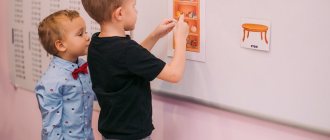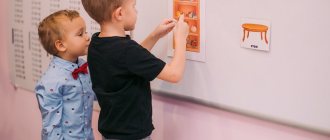Keeping your baby busy with something interesting and useful means not only providing him with the necessary conditions for full development, but also creating an atmosphere of love, mutual understanding and trust between him and his parents. Four-year-olds are already completely independent, inquisitive little individuals with their own interests and needs. Since kids cannot spend all their time outside (and sometimes there is no opportunity for this), a natural question arises: what to do with a 4-year-old child at home?
Physical development
For most children, the annual weight gain is about 2 kg, and height increases by 5–8 cm. However, height and weight may vary significantly among different children.
Table 1. Comparison table. Height and weight of children aged 4 years
| Boys | Girls |
| Height (cm) | |
| low – 94.9 | low – 94.1 |
| average – 103.3 | average – 102.7 |
| high – 115.9 | high – 115.7 |
| Weight, kg) | |
| low – 12.7 | low – 12.3 |
| average – 16.3 | average – 16.1 |
| high – 24.2 | high – 25.2 |
1.1. Motor development
Basic motor skills include walking, running, jumping and other movements. By the age of 4, the baby masters:
- walking on tiptoes, on heels, on the inside and outside of the foot, extended and wide steps, steps with high knee lifts; walking up the stairs with alternating and incremental steps; walking backwards with turning the head;
- confidently maintaining body balance when walking on an inclined surface or curb and when performing a stand on one leg;
- running at different speeds, changing the direction and pace of movement on the go;
- jumping on one or two legs, in place, forward, to the sides, jumping over obstacles, jumping from a small height;
- climbing a vertical ladder, a “liana”, hanging on the crossbar at a height slightly greater than one’s own height.
1.2. Basic self-care skills
By the age of 4, a child should be able to:
- wash your face and hands;
- brush your teeth;
- take a hygienic shower;
- rinse your mouth;
- use a handkerchief for its intended purpose;
- comb hair;
- When eating, use a tablespoon, a teaspoon, a fork, and a napkin;
- unfasten buttons and fasteners;
- dress and undress independently (dress, shorts, tights);
- put on and take off shoes.
At the same time, the child must perform these skills on his own initiative.
When mom is busy
What to do with a child when mom needs to do regular housework and can’t pay attention to the game? If you show a little ingenuity, you can come up with a lot of things that the baby can do on his own, not only without distracting his mother, but also feeling like her indispensable assistant:
- introduce him to cooking: ask him to wash vegetables or fruits, stir the salad in a bowl, put sausage on sandwiches;
- let him help set the table: lay out spoons, napkins, bread, put out a salt shaker;
- when mom works with dough, a small piece of it can become an excellent material for a young sculptor;
- during cleaning, a little helper can be assigned, for example, to sort laundry for washing, wipe dust from low shelves, sort toys in the nursery: arrange cubes, pencils, construction parts, books into proper boxes, water flowers on the windowsills;
- you can invite your child to tinker with the products (peas, beans, pasta) - let him sort them or post a picture;
- A child can feel like an adult if he is offered to “cook” something from real products in “adult” dishes;
- You can ask the baby to make beads for mom (let him string bagels, large beads on a string, or attach clothespins).
To find an interesting and useful activity for your child, you don’t have to constantly play with him, sit him down with gadgets, or come up with something unthinkable. A little imagination and patience from adults - and the issue will be resolved to the benefit of both parties.
Gender differences in the development of preschool children
Differences in the development of boys and girls become most noticeable by the age of four.
Girls' areas of interest include people, relationships between people, the organization of everyday life, and beautiful household items. Boys are trying to transform the existing order.
In relation to things, girls quickly begin to understand their utilitarian meaning. Boys are interested in the structure of each item and the ability to use it for other purposes than its intended purpose. As a rule, many boys are not particularly thrifty with things.
When included in activities, girls do so actively. The boys are getting ready. Girls ask questions during play with a desire to communicate, and boys ask questions to get the information they need. Girls are more fond of games associated with guardianship, a desire to help, and with an educational function. Boys' favorite games are active, without relying on rules.
Construction. Girls usually act according to a model, unlike boys who constantly fantasize, transform and invent everything.
In speech, girls more often use nouns and adjectives, and boys use verbs and interjections.
Studying the characteristics of children's thinking, researchers noted the main gender difference in the structure of the brain. Girls have a more developed left hemisphere, which is responsible for the development of oral and written speech. In boys, it is the right, which is responsible for spatio-temporal representations. The development of girls is characterized by a predominance of visual-figurative thinking, and for boys - abstract thinking. Girls' memory is long-term, while boys' short-term memory prevails.
Thinking
At 4 years old, a preschooler can already:
- comprehend, search and explain cause-and-effect relationships;
- formulate and ask complex questions, as well as answer them independently;
- sort and summarize events, things, people, animals according to common characteristics;
- knows how to isolate what is superfluous and find what is missing;
- occupy yourself for a long time with a book, fairy tale, cartoon, and then comprehend and discuss what you see;
- explain your own behavior, the behavior of other people or characters in fairy tales and cartoons;
- identify your own emotions and share them with others;
- see logical inconsistencies.
Cognitive activities and developmental activities.
What should a four-year-old child know and be able to do and what can he be taught in the future?
3.1. In the field of familiarization with the outside world
A four-year-old child should know and be able to:
- your first and last name, address, parents’ names, your city;
- navigate the premises of your home;
- look at illustrated children's books;
- identify wild and domestic animals, some trees, items of clothing, furniture, and dishes.
Activities to become familiar with the environment help the baby develop. This is an acquaintance with changes in nature, the work of transport, people's work, excursions and more. Everything that interests the child can be observed and discussed. We need to find comprehensive answers to hundreds of “whys”.
It is interesting to carry out simple experiments. For example, the experiment “Why did the water in the bucket freeze in the cold.”
Starting from the age of 4, children should be taught to group familiar objects according to their purpose (cup, plate, saucer are utensils), i.e. make generalizations.
3.2. In the field of elementary mathematics
The baby already knows how to:
- compare the number of objects in groups of up to 3 based on counting, application, overlay;
- group objects by color, size and shape;
- distinguish and name geometric shapes - circle, square;
- understand the expressions: “above - below”, “in front - behind”, “left - right”, “on”, “above - under”;
- distinguish and name day, night, morning and evening, as well as seasons and their signs.
Since the concepts of “one” and “many” have already been formed, you should move on to the new concepts of “one at a time” and “none”, and also master counting to 5.
It’s time to teach your child to understand the questions “Is it equal?”, “What is more (less)?”; answer questions using sentences: “I put a berry on each leaf. There are more leaves, but fewer berries” or “There are as many leaves as berries.”
Ideas about size should not be reduced only to the concepts of “big - small”. It is necessary to introduce the child to the concepts of “wide - narrow”, “long - short”, “high - low”.
New geometric shapes to introduce your child to are rectangle and triangle. We need to teach them to distinguish them; it is not necessary to name them.
3.3. In the field of speech development
A four year old can:
- use all parts of speech in conversation, simple sentences of 6–8 words;
- agree words in gender, number and case;
- pronounce all vowel sounds clearly;
- maintain a conversation with peers and adults;
- briefly talk about the content of the story picture with the help of questions and prompts from an adult;
- repeat the description of a familiar toy;
- briefly retell the plot of a fairy tale;
- memorize a short poem.
The speech of these kids is amazing and funny. Four-year-olds can endlessly invent new words.
Speech development activities are varied. This is reading books with discussion of the content, memorizing poetry. Along with well-known fairy tales (“The Three Little Pigs”, “Spikelet”) and literary works (“Sparrow” by M. Gorky, fairy tales by H. H. Andersen), you can start reading excerpts from “thick” books (“Winnie the Pooh and all-all- everything" by A. Milne). You shouldn't limit yourself to just reading. We need to start mastering retelling. First with questions, and then independently. In this case, you should pay attention to the grammatically correct construction of sentences.
Conversations on various topics and descriptions of paintings by famous artists that are understandable to a child broaden their horizons significantly.
Memory is not only visual
It is human nature to remember what he sees, hears and does. Therefore, memory development should be aimed at all of these aspects.
- Visual memory is well trained by looking at pictures with their subsequent description, as well as remembering the location of objects in the room. You can ask your child what he was wearing yesterday. Develops visual memory by playing to rearrange toys: several objects are placed, and when the child turns away, they are swapped. The preschooler's task is to guess what has changed.
- Auditory memory is trained by learning nursery rhymes and rhymes. It is advisable to learn four lines a day. It is imperative to retell fairy tales and share impressions of what you saw, and everything needs to be told in detail. You can also give your child play tasks: buy in a “store” according to an oral list or set the table according to certain instructions, also spoken orally.
- Motor memory is trained during games in which you need to repeat the movements of adults. Once a certain game is learned, an adult can “accidentally” make a mistake; the child’s task is to find and correct the mistake.
Socialization
Gradually learning ethical standards, four-year-olds try to follow the rules of behavior in society. In doing so, they must be able to:
- evaluate the actions of peers (good - bad);
- understand the meaning of words denoting emotions (joy, sadness);
- take on any role in the game;
- follow the rules of the game;
- have an idea of some professions, portraying their representative in a role-playing game.
Active movement
It is clear that playing football or long jumping in an apartment with a child is unlikely to be possible, but there are many activities that promote physical activity for the baby:
- "Children's library." That is, a playful, children's disco with funny, imitative movements, pantomimes. If other children are visiting, you can arrange a competition. Young dancers may be even more interested in the prospect of a prize for the winner.
- Games with balloons. There can be many options: who can hold more balls, who will burst faster, who will keep the ball in the air longer...
- Games with balls, fitball. You can throw them, catch them, catch them, jump on them, or come up with something else.
- Hide and seek. Both children and adults, as well as the objects they choose, can hide.
- Children's bowling alley or basketball. They usually don’t require much space, and they awaken the child’s excitement.
- Relay races between tables, pillows, chairs, ropes stretched between them, etc.
When conducting such games, pay attention to safety: so that children do not stumble, do not slip on carpets, do not knock over something valuable with a ball, or accidentally get injured by broken glass objects, the area of such games must be safe.
Visual activities
By the age of four, children have mastered the skill of using a pencil, felt-tip pens and a brush. They know how to depict the shape of an object (round, square) and select a color. Kids can depict several objects united by a single plot (tumblers dancing, snow-covered trees in the forest). Details appear on the depicted objects. At the same time, the concept of composition is formed: what is important and secondary in the drawing.
In the future, the young artist will be faced with new tasks: to learn to depict figures in motion (a bird raised its wings, a fox runs after a hare, the Snow Maiden dances).
When coloring pictures, a child of this age should not go beyond the edges of the outline of the picture.
ATTENTION PARENTS. The design of the drawing may change during the child’s creative activity. Sometimes the imagination of a young artist goes so far that it is better to promptly offer to complete the process and send the creation to the vernissage.
Children love to make appliqué from ready-made forms: “Let’s decorate the Christmas tree with balls and flags,” “Let’s pickle cucumbers in a jar,” “Let’s decorate the doll’s dress.”
During modeling classes, kids can roll out balls and sausages, connect parts with each other, getting a complete image (snowmen, carrots). They are capable of pinching and pulling out parts (ears on a kitten, beak on a chicken), as well as smoothing sculpted surfaces. Salt dough, clay, and plasticine are used for modeling.
Other knowledge
A preschooler needs to develop, for example, geographical knowledge (concepts about living and inanimate nature, seasons).
It is recommended to read encyclopedias more often, look at globes or geographical maps. It is worth noting that geography is one of the most important sciences for a 4-5 year old child. By studying this science, a preschooler will find answers to many questions of interest.
Show your child paintings by Russian artists, describe every detail, its origin and purpose.
Musical creativity
Four-year-old children usually show an interest in music, a desire to listen and perform. They recognize familiar melodies and name them. When listening to music, they can determine whether it is sad or happy, loud or quiet, fast or slow.
They sing children's songs with pleasure. They dance with great enthusiasm to the music or singing of an adult, performing movements according to the text of the song. They love to beat out the rhythm of music on noise musical instruments: xylophone, drum, maracas.
VERY IMPORTANT! Since the main activity for preschoolers is play, when starting a lesson, you cannot say to your child: “Let’s work out”! We must say: “Let’s play.” Learning occurs during the game.
ATTENTION PARENTS! If you notice that your baby is lagging behind other children in development, this is a serious reason to contact a pediatrician or pediatric neurologist. You can't pull. The sooner help is provided, the more likely it is that the baby will catch up with his peers.
Fine motor skills of children 3-4 years old
Game No. 1 “Delicious porridge”
Speak and show movements. Let the child repeat after you. You can modify the movements. This very simple game will become your favorite. The child will learn a memory rhyme, perform movements to develop fine motor skills, and at the same time feed the doll.
I’ll cook porridge for the doll: (Rotate your hands.)
I will pour milk into a bowl (Clench your fist and make a movement as if pouring from a bottle.)
I'll put the cereal there (Make loose movements.)
And I'll put it on the stove. (Open your palms.)
The porridge will be good! (Clap your hands.)
Eat, doll, slowly. (Threaten with your finger.)
More finger games here
Game No. 2 - develops motor skills very well
We sculpt together with the child (from plasticine or dough)
Modeling is No. 1 in the development of fine motor skills in children aged 3-4 years. Children are interested in creating their own toys, figures, houses. We have selected for you a small collection of figures made of plasticine or dough.
Attention! How to copy coloring pictures from our website?
- Choose any picture. Right-click on the picture.
- Select "Save Image As". Save it in a convenient folder and print it from there!
Game No. 3 “Collect beads”
Stringing buttons, beads, pasta, dryers and anything else on a fishing line or thread is good for developing children's hands! Kids love this activity, because then they can wear this jewelry or give it to their mother. Start with objects that have a wider hole - this will make it easier for your baby to master this task at first. In summer, you can use berries as beads - rowan, viburnum, leaves, etc.
A selection of a wide variety of decorations for the development of motor skills
Games
Games for preschoolers are divided into:
- role-playing;
- didactic;
- movable;
- theatricalization.
In role-playing games, everyone takes on a certain social role. These are games on everyday topics: “Family”, “Doll’s Birthday”, “Our Favorite Fairy Tale” and others. By imitating adults, children imitate the life of society and learn ethical standards. Children can play. The duration of the game reaches 40 – 50 minutes.
Didactic games develop memory, attention, intelligence, and analytical skills. Didactic games include various sorters of objects by color, size and shape; puzzles, paired pictures, “Tangram”, “Find out what’s in the bag”, “Who hears what”, “What’s missing” and many others. When choosing a didactic game, you should pay attention to what age it is recommended for.
Outdoor games develop qualities such as dexterity, courage, speed of reaction, and the ability to follow the rules. For four-year-olds, these are the games “Sparrows and a car”, “Hares and a fox”, “Bear in a forest”, traps, hide and seek and others.
Theatricalization is a reenactment of the plots of your favorite fairy tales and cartoons. They develop the child's creative abilities.
Developing speech
Here are some simple but effective exercises that you can do at any time:
- “What happens...” Tell your child the characteristics of an object and ask what happens with such characteristics. Gradually, the task can be complicated by combining several characteristics at the same time.
- “What happens if...” Come up with any plot situations and wonder what will happen in this case.
- "What can be done…". Any object is taken and the question is asked what can be done with it. You can also ask what not to do and why.
- "What and where." Ask your child basic questions. For example, where is the frying pan or TV. Ask to describe all items from any room in as much detail as possible.
- Describe any animal to your baby and ask him to guess. Change roles: let the child try to act as a mystery teller.
- Play onomatopoeia. Pay more attention to problem sounds (usually s, sh, z and r).
IMPORTANT! Be sure to learn poems, songs, fairy tales, and read a lot. Discuss what you saw and heard. The development process must be continuous.
Also read about toys for children's speech development.
Games to develop logical thinking
Logical skills are well used in the following exercises:
- Generalize objects according to any characteristic (for example, find everything round, flat, yellow).
- Determine the similarities and differences between pictures or individual objects.
- Select identical objects from many.
- Assemble the constructor according to the sample.
- Find an extra item and explain your choice.
- Select paired objects, name the characteristic by which the choice was made.
- Find a way out of the maze. Such tasks are found in all children's magazines and educational publications).
Daily regime
A child who has reached the age of 4 years has a more balanced nervous system than a younger preschooler. Two hours of daily sleep is enough for him.
A whole hour can be devoted to developmental classes in the morning (2 lessons of 20 minutes each with a break). You should not devote a long time to classes, otherwise the child’s brain may switch to inhibition mode, and the baby will learn little from such a “lesson.” During the day, you should combine complex classes on speech development, familiarization with the environment and elementary mathematics with creative activities. This requirement is related to the need not to overstrain the child’s brain.
| 7.30 | awakening, hygiene procedures |
| 8.00 | morning work-out |
| 8.30 | breakfast |
| 9.00 | developmental activities |
| 10.00 | walk |
| 11.15 | free games, preparing for lunch |
| 12.00 | dinner |
| 12.30 | preparation for nap |
| 12.45 | dream |
| 14.45 | watching cartoons, playing games, communicating with adults |
| 15.30 | afternoon tea |
| 16.00 | walk |
| 18.30 | games, communication with adults, helping mom as much as possible |
| 19.00 | dinner |
| 19.30 | communication with adults, reading books, games |
| 20.30 | water procedures, preparation for bed |
| 21.00 | night sleep |
Walks on tiptoes - what to do?
There are only 4 reasons why a four-year-old child walks on his toes:
- Psychological - a completely healthy child walks on his toes because he imitates someone, tries to appear taller, or he simply does not like touching any surface with his sensitive feet (a scratchy rug, cold tiles).
- Behavioral – If toe walking is only one aspect of the strange behavior, this may indicate the presence of autism.
- Neurological – cerebral palsy, muscular dystrophy, impaired coordination of movements. In such conditions, the calf muscles are always tense, impossible to relax, and because of this the child cannot lower his heel.
- Orthopedic – inflammation of the calcaneus, short calcaneal tendon, clubfoot. All these ailments are reflected by pain when lowering onto the heel.
Important! If you see that your child constantly walks on tiptoes, often stumbles and is generally poorly coordinated, consult a neurologist.
Logics
At 4 years old, a child is able to concentrate attention on an event or action a little longer than at 3 years old, and accordingly, build the following logical relationships:
- be able to count to 10 and navigate these numbers (5 is less than 8, 8 is more than 7);
- rewrite letters or numbers based on the picture;
- compare objects by shape and size;
- sketch simple geometric shapes;
- combine and separate objects by properties;
- separate the fictional from the real;
- navigate in space and remember familiar routes;
- remember your home address;
These skills are the foundation for the further development of logic and mental abilities.
What should a child do?
4 years is the age when a child is very mobile, active and inquisitive. He is interested in almost everything, so it is necessary to immediately maintain his enthusiasm and engage in educational games with him. For example, modeling, drawing. Children sculpt and draw at an earlier age, only then the technique is quite primitive. At this point, you can show them how to hold a drawing brush or felt-tip pen in your hand, and how to correctly outline figures. You can trace the drawings along the contour or with a stencil. You definitely need to buy coloring books for your child so that he can fill in black and white drawings with color. In addition to developing imagination, fine motor skills develop.











